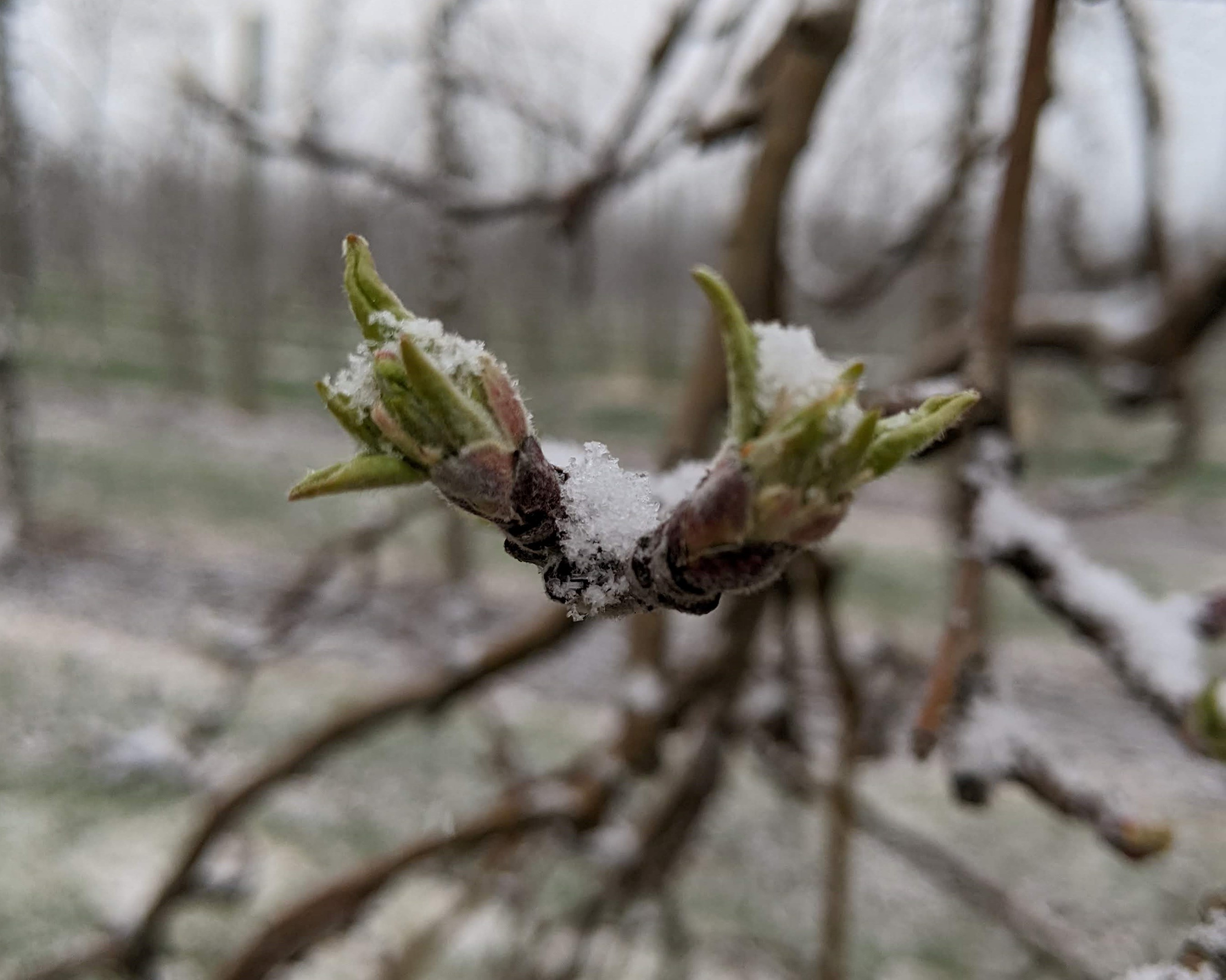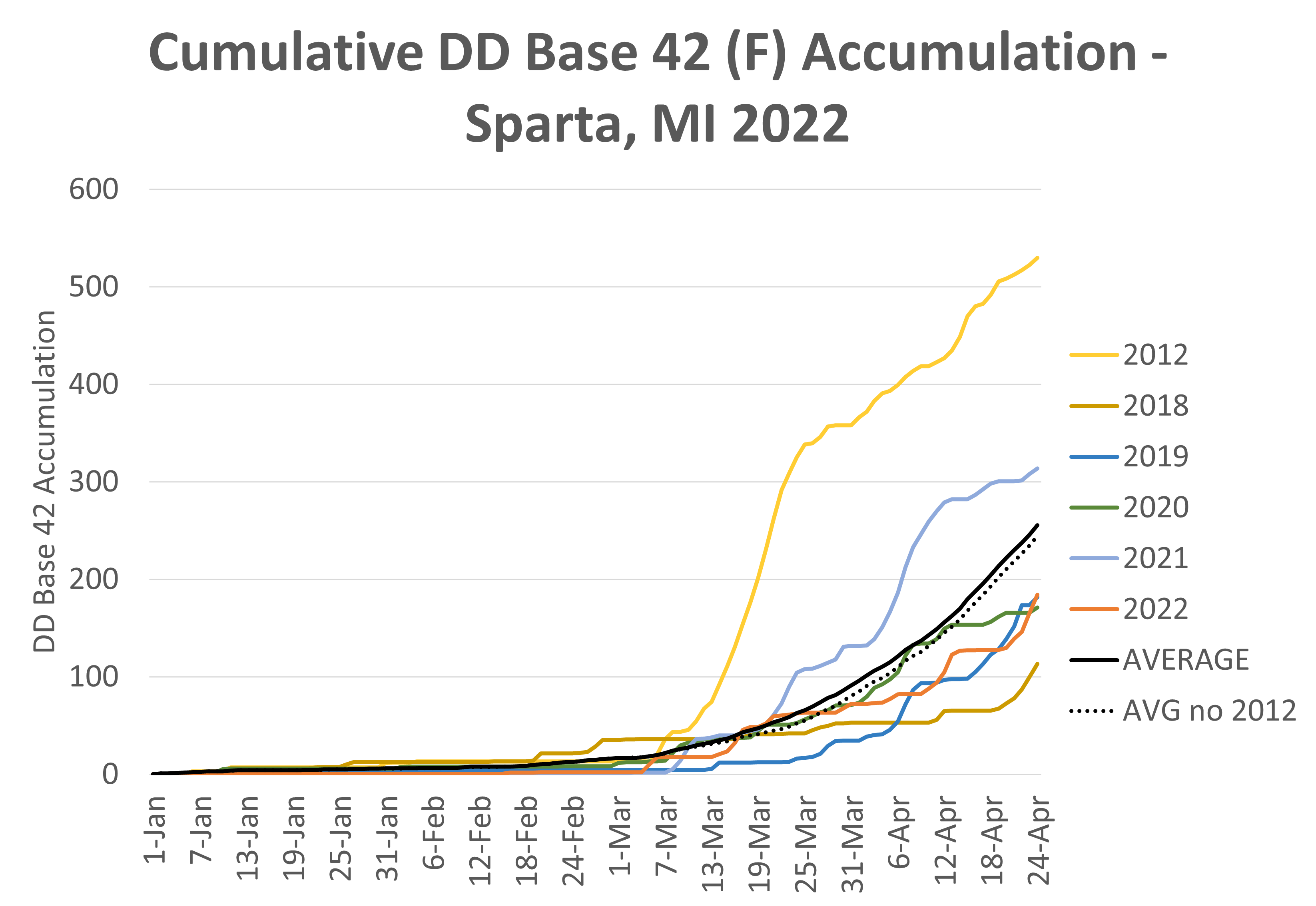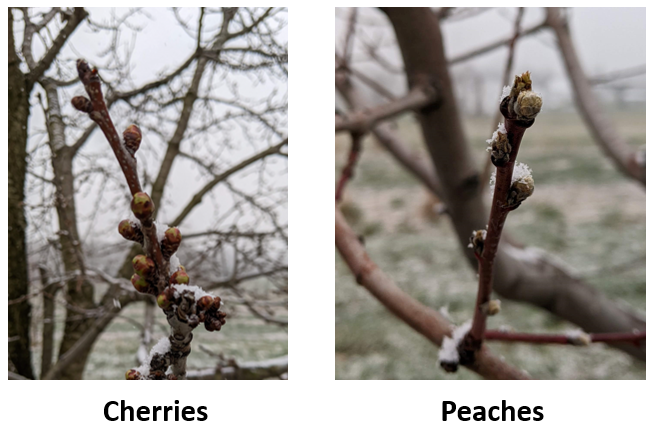Grand Rapids area tree fruit update – April 19, 2022
Snow at the beginning of the week, then warming to highs in the 70s on Thursday. Most apples are between 0.25- and 0.5-inch green.

Weather and phenology update
In the Grand Rapids, Michigan, area, temperatures have been cold and trees have continued to move very slowly. As of April 18, the Michigan State University Sparta Enviroweather station has accumulated 127.6 growing degree days base 42 degrees Fahrenheit (GDD42). This is below average, which is 204.3 GDD42. Most of the warming over the past week took place on Monday and Tuesday, with temperatures in the 60s F (about 20 GDD42 over two days). Since Tuesday, however, high temperatures have been in the 40s and 50s, resulting in very little heat accumulation (less than 5 GDD42).
Rainfall has been relatively even across the region and fields continue to be wet. Between 0.5 and 0.75 inches were recorded at weather stations across the area last week on Wednesday and Thursday, and about 0.1-0.2 inches over the last 24 hours.
Most apple varieties reached green tip on approximately April 12-13 and are now between green tip and 0.25-inch green. Some warmer blocks and early varieties have reached 0.5-inch green, such as Gingergold and Idared. Cherries and peaches are at approximately green tip and calyx green, respectively.

By the end of the week, temperatures are expected to warm again. Over the next two days, expect cool temperatures and likely precipitation late/overnight Wednesday with about 0.25 inches of rain. Then, forecasted temperatures include highs in the 60s and 70s on Thursday and through the weekend, accompanied by dry conditions. Overnight lows will be in the 40s and 50s at the end of the week, then in the 30s over the weekend. The projected heat accumulation through Sunday, April 24, is 184.1 GDD42. This continues to be below average, which is 255.2 GDD42. This is expected to be followed by cooler temperatures, and another chance of 0.5 to 0.75 inches of rainfall next week.
Based on the current growth stage and predicted temperatures, there is very low risk of frost injury. Through 0.5-inch green, critical temperature thresholds for injury in Red Delicious are 23 F for 10% and 19 F for 90% mortality. With the current forecast, there is no risk of injury. View a chart with the critical temperatures for phenological stages from Michigan State University Extension.

|
GDD42 accumulation and forecast for Sparta | ||||
|---|---|---|---|---|
|
Day |
Date |
2021 |
2022 |
Average |
|
Su |
4/24/2022 |
313.8 |
184.1 |
255.2 |
|
Sa |
4/23/2022 |
308.0 |
165.1 |
245.4 |
|
F |
4/22/2022 |
301.3 |
146.1 |
237.6 |
|
Th |
4/21/2022 |
300.4 |
139.1 |
229.8 |
|
W |
4/20/2022 |
300.4 |
129.7 |
221.9 |
|
Tu |
4/19/2022 |
300.4 |
127.6 |
213.8 |
|
M |
4/18/2022 |
298.0 |
127.6 |
204.2 |
|
Su |
4/17/2022 |
292.3 |
127.6 |
195.7 |
|
Sa |
4/16/2022 |
286.6 |
127.0 |
188.0 |
|
F |
4/15/2022 |
282.1 |
127.0 |
179.5 |
|
Th |
4/14/2022 |
282.0 |
126.9 |
169.7 |
|
W |
4/13/2022 |
281.9 |
122.5 |
162.2 |
|
Tu |
4/12/2022 |
278.8 |
104.5 |
155.8 |
|
M |
4/11/2022 |
269.7 |
93.9 |
149.0 |
For these updates, we used averages for 1997-2021 from the Michigan Automated Weather Network (MAWN) to represent normal conditions. Weather data was gathered from MSU Enviroweather.
More information and reports on normal weather conditions and departures from normal can be found on the NOAA Climate Prediction Center website, NOAA U.S. Climate Normals website, NOAA Climate Normals Quick Access Page (which may be searched by region) and Midwest Regional Climate Center website.
Pest updates
Spring is trying to get here and by the end of this week, it should fully arrive. The pest complex for tree fruits is still in a holding pattern until then.
Fruit diseases will become a concern in the Grand Rapids area starting this week with warmer weather in the forecast and enough green tissue for infections by the end of the week. The first management spray for apple scab and fire blight is copper. With the cool weather in the forecast, copper sprays will give long-lasting control for both fungal and bacterial pathogens. Apple scab inoculum is likely lower than usual given low disease pressure in 2021, but by the end of this week, they will be well timed with developing green tissue. The forecast will put degree accumulations base 42 at about 190 or so by the weekend—this is the amount of heat units typically needed to reach the 0.5-inch green stage in apples.
Here are some insects to be thinking about now as you plan for monitoring and management.
Black stem borer - A few adults could begin some active this week with warmer weather and cool weather will depress flight. It’s time to think about getting traps up.
Green fruitworm – This is a minor pest in tree fruit, but we still see some damage from larval feeding in any given year. Adult flight likely to begin this week, with some warmer night temperatures in the forecast.
Redbanded leafroller - No adult flight reported in the general Grand Rapids area yet. First flight could begin by the end of this week.
Spotted tentiform leafminer - No adult flight reported in Michigan. You should plan to trap for it if you’ve had high numbers. Expect adult flight to begin with warmer weather at the end of the week.
Obliquebanded leafroller - No activity of overwintering larvae reported as there is little to no green tissue to feed on. Once green tissue appears, monitor for small larvae in problem blocks.
Aphids - No reports of any species yet. Apple grain aphids will be the first to be seen as individuals on terminals. Rosy apple aphids usually appear around pink.
San Jose scale - Overwintering scale are present. Management sprays should be considered for orchards where scales were present on fruit in the 2021 harvest and dormant oil is first management choice to consider.
European red mite – Is in the egg stage and not active in such cool temperatures. Monitor for overwinter egg mortality. If eggs look pale or clear instead of bright red, they are not viable.
Climbing cutworm – Will hang out in the soil until warmer weather and green tissue occur. While this is a very minor pest, we do see increased damage in a cool, drawn out spring as this year is.
Pear psylla - Adults could be present with the warmer weather of late. Expect increased adult activity near first green in pears and start management in high pressure blocks.



 Print
Print Email
Email





